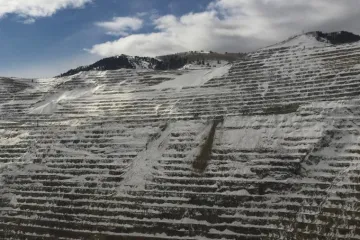Can thermal imaging save miners’ lives?

August 2020
Astronomers use thermal imaging cameras to study the heavens. Military troops deploy them to monitor enemy movements. Manufacturers focus them on equipment to detect dangerous heat levels.
Starting this fall, University of Arizona’s Geotechnical Center of Excellence (GCE) will test them at open pit mines to see if they can detect rock fall events and possibly predict those events and slides before they occur. If the cameras can sufficiently measure the movement of rocks, it could save miners from injury or death.
The CDC’s National Institute for Occupational Safety and Health (NIOSH) has selected GCE’s application for nearly $400,000 in funding.
“Rockfall events are a critical safety risk for the mining industry,” said Bradley Ross, GCE director. He and GCE co-director Chad Williams are principal investigators for the two-year study. “We want to see if we can systematically detect rockfall events and see conditions before a rockfall occurs.” The GCE has just hired a new engineer, Ed Wellman to lead the work on this project. Ross: "Ed is an experienced geotechnical engineer and very well known in the mining industry. His background and interest are a great fit for making this to be a very successful project."
The GCE is part of the Lowell Institute for Mineral Resources, which fosters academic-industry partnerships. Companies have expressed keen interest in this project. “With most research projects, it’s difficult to get corporate collaboration,” Ross explained. “One of the indications of this project's importance is the large number of companies that would like to have this test done at their sites.”
Making an improving situation better
Although mining safety as a whole continues to improve, rockfall events remain an issue. Between 2018 and 2019, NIOSH recorded 59 injuries and one fatality in the United States from rolling or sliding rock. In the same time period, the International Council on Mining & Metals logged seven fatalities. The council compiles safety date from its 27 member companies and 36 member associations from around the world.
Miner safety can be improved by filling the hole in monitoring for dangerous rock movement, insisted Ross. Currently, no technology is used for this safety issue. “There has never been a system, other than human observation, that could systematically detect and warn about rockfall events,” he said. But human observation has serious limitations. Thermal imaging cameras can work under conditions that humans and other monitoring systems can’t, such as in the dark of night or inclement weather conditions. Plus, they do not get bored or need to take a break.
How thermal cameras detect danger
The equipment reveals temperature differences in areas they are aimed at. Warm-blooded animals, for instance, register in different colors than their cooler inanimate surroundings.
Moving objects create kinetic energy that heats the air around it. The falling rock also uncovers layers of dirt or rock that has a different temperature than material that is not disturbed. This path of energy and freshly disturbed rock can be detected and recorded by thermal imaging cameras.
It is this movement that the researchers hope to detect, record and analyze. They hope to develop a technique that detects and recognizes these hazardous events. A system can then be developed that warns of these movements to give mine workers precious time to get out of the way or allow a company to address the threat.

Different technologies and several mines
The project starts with buying four thermal imaging cameras that are similar to what’s used by the military. Each will have different features and price points. They will be mounted on a trailer that also will house recording and data storage equipment.
Researchers have identified five mines where they will test the equipment. Each mine will be visited in a different season. Testing will occur under several weather and geological conditions. Ross expects all of the sites will be in North America, with the final locations dependent on COVID-19-related travel restrictions.
In the first phase of the study thermal cameras will record data from researchers intentionally pushing manmade concrete rocks over a high wall. This will allow the researchers to calibrate the results based on known parameters. In the second phase, they will monitor a variety of mines at different frames so that all four thermal cameras can detect the same rockfall events. By recording the same events with different cameras, the capability, and limitations of each camera can be determined.
The thermal cameras will also record the pit slope conditions leading up to the rockfall events. By recording and understanding the conditions that result in rockfall events, the hope is to prevent or mitigate the hazards before the events ever happen.
During the study, researchers hope to test Doppler radar equipment, which uses different technology to detect moving rocks. Two radar manufactures are developing these systems to detect rockfall events. Although such radar systems are not yet commercially available, the team hope to include one of these systems in the test to evaluate their capability and limitations as well. Radar may not be able to detect conditions that may lead to rockfall, however, “it may end up making sense to use both so there is redundancy,” posited Ross.
“The project is intended to prove which technology can fit in the mining industry,” he said. “Our job is to determine their actually capability and limitations so they can be effectively used to protect miners.”


